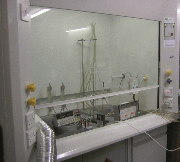 Gas detection equipment forms a significant part of the products used in potentially explosive environments. With a range of differing gaseous environments, manufacturers of gas detection equipment need to ensure their products meet stringent testing criteria to operate safely and reliability. Clive Tester of CSA-Sira explains
Gas detection equipment forms a significant part of the products used in potentially explosive environments. With a range of differing gaseous environments, manufacturers of gas detection equipment need to ensure their products meet stringent testing criteria to operate safely and reliability. Clive Tester of CSA-Sira explains
Regarding toxic gases, by far the bulk of CSA-Sira’s work is centred around carbon monoxide sensors. These are predominantly of electrochemical design for the lower concentration applications, and of the infra red photometry principle for the higher concentration ranges.
The electrochemical cell design for carbon monoxide detection is robust and cost effective, but these sensors can lose sensitivity when exposed to high carbon monoxide concentrations. During the calibration of these systems, the engineer must be mindful to allow sufficient recovery time following exposure to high CO concentrations. Ambient humidity with electrochemical cells is also an important factor in their performance characteristics. Relatively short exposure to dry test gases as is normally required during calibration work will not adversely affect the sensor. However, it is important to remember that long exposure to dry conditions can dry the sensors and lead to a reduction in their performance.
Sensors based on infrared photometry are not subject to the same issues with exposure to high concentrations of carbon monoxide or exposure to dry conditions. These are however, more complex in design and more expensive.
Flammable gases
Of the technology in the current market, CSA-Sira mainly focuses on infrared photometry and catalysed bead pellistor technology which is robust and cost effective. However, the catalytic bead of the pellistor may become desensitised by exposure to gases containing silicon, lead, sulphur, phosphorous and halogens. They may also become desensitised by exposure to high concentrations of combustible gases and some heavier hydrocarbons. As the reaction involves the oxidation of the combustible gas, test gases must contain a sufficient level of oxygen. It must also be noted that pellistors are non-selective, and will give a response to any combustible gas. For pellistor-based sensors, the response curves vary significantly between different gas types. It is therefore important to match the calibration gas type to the application for which the unit under test is to be used.
The poisoning effects of which pellistor-based systems are prone, do not for practical purposes affect infrared photometry. Atmospheric water vapour can have an interfering effect on infrared-based systems. At the CSA-Sira gas detection laboratory, ambient conditions are kept within strict relative humidity and temperature limits. Thus the effects of water vapour interference during calibrations do not present an issue.
Oxygen
Electrochemical oxygen cells are the predominant type of sensors on the market and these are submitted to CSA-Sira for calibration. One of the characteristics of liquid electrolyte galvanic oxygen sensors is that their response is perturbed by sudden changes in air pressure. Thus it is important during the application of calibration gases to these devices, to avoid pressure changes at the cell interface.
US performance testing
With the acquisition of Sira Test & Certification by CSA Group, CSA-Sira has recently started performance testing for the North American and Canadian markets. Testing currently covered by CSA-Sira, is that which falls within CSA-Sira’s current capabilities – that is IEC/EN standards.
For combustible gas detectors, the Canadian market requires testing to C22.2 No 152-M1984 and the US requires testing to ISA 12.13.01. The performance requirements of these standards are required to meet certification to CEC Section 18 and Annex J and NEC 500/505 in Canada and the US respectively. For equipment requiring certification to European US and Canadian standards, performance testing against IEC 60079-29-1, C22.2 No 152 and ISA 12.13.01 are therefore required.
Hence, to meet the testing requirements of the US and Canadian markets, CSA-Sira is currently undergoing an expansion and modification of its existing facilities to allow testing against the North American and Canadian standards. A recent review by CSA-Sira has shown that there exists a considerable cross over between testing performed under US and European standards. Hence little modification to CSA-Sira’s current testing facilities is required for the US market. There are however some differences between the European and Canadian standards.
A good example of where CSA-Sira is incorporating the US and Canadian testing into their capabilities is with the IEC/EN Time of Response test for combustible gas detectors. In IEC/EN 60079-29-1 this is covered in clause 5.4.16. Essentially the same test is covered in the Canadian standard under the Step Change Response and Flooding tests, and in the US standard under the Time of Response test. All three standards subject the unit under test to a rapid step change from air to a test gas. In effect the test measures the response time of the detector to an instantaneous change in conditions. The three standards are descriptive in the testing apparatus. The type of apparatus adopted currently at CSA-Sira differs from that in the US and Canadian standards. CSA-Sira is currently evaluating new testing apparatus that can be adopted between the three standards, and the CSA laboratories will be integral in this design plan.
CSA-Sira
T: 01332 520 500




